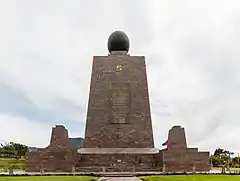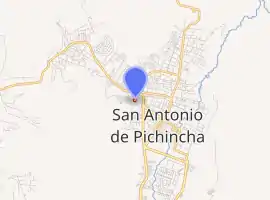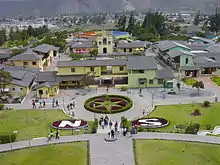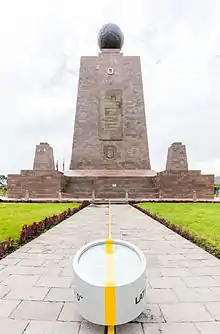Ciudad Mitad del Mundo
The Ciudad Mitad del Mundo (Spanish: [sjuˈðað miˈtað ðel ˈmundo], Middle of the World City) is a tract of land owned by the prefecture of the province of Pichincha, Ecuador. It is located at San Antonio parish of the canton of Quito, 26 km (16 mi) north of the center of Quito. The grounds contain the Monument to the Equator, which highlights the exact location of the Equator (from which the country takes its name) and commemorates the eighteenth century Franco-Spanish Geodesic Mission which fixed its approximate location; they also contain the Museo Etnográfico Mitad del Mundo, Ethnographic Museum Middle of the Earth, a museum about the indigenous people ethnography of Ecuador.
| Ciudad Mitad del Mundo | |
|---|---|
 The Monument to the Equator (Monumento a la Mitad del Mundo) | |

| |
| Type | Museum park and monument |
| Location | San Antonio parish, Quito, Ecuador |
| Coordinates | 0°00′08″S 78°27′21″W |
| Operated by | Prefecture of Pichincha |
| Status | Open all year |



The 30-metre-tall (98 ft) monument was constructed between 1979 and 1982 by Pichincha's Province Council to replace an older, smaller monument built by the Government of Ecuador under the direction of the geographer Luis Tufiño in 1936.[1] It is made of iron and concrete and covered with cut and polished andesite stone. The monument was built to commemorate the first Geodesic Mission of the French Academy of Sciences, led by Louis Godin, Pierre Bouguer and Charles Marie de La Condamine, who, in the year 1736, conducted experiments to test the flattening at the poles of the characteristic shape of the Earth, by comparing the distance between a degree meridian in the equatorial zone to another level measured in Sweden.[2] The older monument was moved 7 km (4.3 mi) to a small town near there called Calacalí.[3]

The UNASUR headquarters is currently under construction in this place.[4] Contrary to popular belief, there are only two points of interest positioned exactly on the equator: the Catequilla archaeological site,[5][6] and the Quitsato Sundial.[7]
The French Geodesic Mission
The placement of the equatorial line was defined throughout a 1736 expedition called the French Geodesic Mission. While such studies would later determine the exact measure and shape of the world, astronomers involved missed the possibility of encountering the remnants of highly sophisticated geographical achievements made on “Equatorial” territory for hundreds of years before their arrival. Throughout the time the astronomers attempted to measure a length of a degree of latitude on that part of the planet, a group of different sorts of ruins (built by the Quitu-Cara culture) were found nearby the territory where they thought the Equatorial line passed through. Years after that, it was brought to light that the "Geodesic Mission" had been wrong about the exact coordinates where the line passed through—the measurements had indeed proved the world was oblate and not elongated (egg-shaped) at the poles, but their studies to define the placement of the equator were incorrect by 240 metres (790 ft). The Catequilla ruins found throughout the expedition between 1735-1745 were actually situated at latitude 0 (0°0′0″N 78°25′43″W), or the exact position where the Equatorial line crosses.
In 1935, the Ecuadorean Government built a ten-metre-high (33 ft) monument to honor the French expedition under the guidance of local geographer Luis Gudiño. In 1972, that monument was replaced by a thirty-metre-high (98 ft) monument titled “Ciudad Mitad del Mundo” (Middle of the World City), regardless of the inexact coordinates (which by then could be measured through GPS).
Latitude discrepancy
Based on data obtained by Tufiño, it was believed that the equator passed through those two sites. However, according to readings based on the World Geodetic System WGS84, used in modern GPS systems and GIS products, the equator actually lies about 240 metres (790 ft) north of the marked line.
Over the years, countless tourists have had their pictures taken straddling the line drawn down the center of the east-facing staircase and across the plaza.
The pyramidal monument, with each side facing a cardinal direction is topped by a globe which is 4.5 metres (15 ft) in diameter and weighs 5 tonnes (4.9 long tons; 5.5 short tons). Inside the monument is a small museum that displays a variety of indigenous items pertaining to Ecuadorian culture: clothing, descriptions of the various ethnic groups, and examples of their activities.
Ciudad Mitad del Mundo contains other attractions such as a planetarium, a miniature model of Quito, and restaurants. On weekends, Ciudad Mitad del Mundo's Central Plaza hosts varied musical and cultural events for tourists. Also, there are diverse local handcraft stores and local food served at several cafés along a colonial small town.
Intiñan Solar Museum
200 metres (660 ft) northeast of the Ethnographic Museum Monument is a local private attraction, known as the Intiñan Solar Museum, reportedly built to mark the Equator, although modern measurements suggest that it no longer does.[8]
Except for the exhibitions of Ecuadoran culture, the museum is an amusement for credulous tourists.[9] Tour guides and visitors demonstrate tricks which are supposedly possible only on the Equator, such as water flowing both counter-clockwise or clockwise down a drain due to Coriolis effect,[10] balancing eggs on end,[11] or weakening of muscles due to latitude.[12] Some tour guides will admit the truth that proximity to the equator has no measurable influence.[13][14]
References
- Del Castillo, Eduardo (1986). Geografía del Ecuador. Quito-Ecuador: Libresa. p. 5. ISBN 997880029-8.
- Lafuente, Mazuecos, Antonio (1992). Los Caballeros del Punto Fijo. Abya-Yala. p. 70.
- Del Castillo, Eduardo (1986). Geografía del Ecuador. Quito-Ecuador: Libresa. p. 6. ISBN 997880029-8.
- "Llega Alí Rodríguez a Ecuador para asumir Secretaría General de Unasur". Spanish People Daily. 14 June 2012. Archived from the original on 4 February 2014. Retrieved 30 June 2012.
- Cobo, Cristóbal (2004). "El sitio arqueológico Sobre el Monte Catequilla en la Latitud Cero". Memorias del Simposio ARQ-13 del 51 Congreso Internacional de Americanistas (in Spanish). Chile: Pereira editores.
- Awake!. "Nahua/Maya Number system AMAZING DISCOVERIES at EARTH'S EQUATOR". Archived from the original on 5 May 2012. Retrieved 8 July 2012.
- Instituto Geográfico Militar de Ecuador (24 January 2005). "Memoria Técnica de la Determinación de la Latitud Cero" (in Spanish).
- "12/12: Mitos de la Mitad del Mundo". Archived from the original on 2017-04-30. Retrieved 2012-06-27.
- "Ecuadorian Equatorial Pseudoscience". 2020-01-08. Retrieved 12 January 2020.
- Mikkelson, Barbara. "Flush Bosh".
- Helmenstine, Anne Marie Ph. D. "Can You Balance an Egg on the Equinox?". about.com Chemistry Section. Retrieved 18 March 2012.
- "Why did my muscles turn to jello on the Equator?". Retrieved 11 January 2007.
- Penn State University, "Bad Coriolis"
- Bad Astronomy, "Stand an egg on end"
External links
- http://www.mitaddelmundo.com/ Ciudad Mitad del Mundo official site.
- http://www.cotopaxitours.com/ Tours a la mitad del mundo.
- http://www.museointinan.com.ec/ Intiñan Solar Museum Site.
| Wikimedia Commons has media related to Mitad del Mundo. |